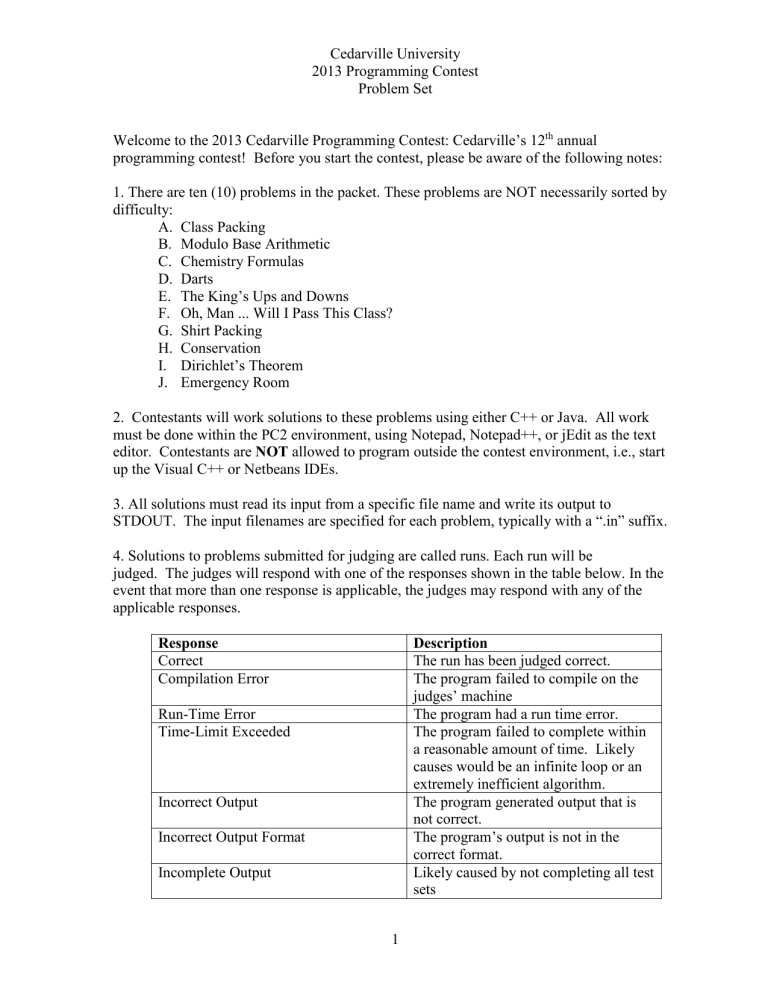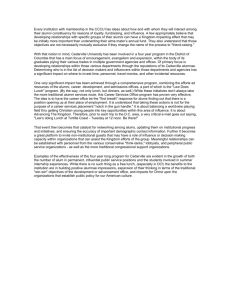Problems - Computer Science at Cedarville
advertisement

Cedarville University
2013 Programming Contest
Problem Set
Welcome to the 2013 Cedarville Programming Contest: Cedarville’s 12th annual
programming contest! Before you start the contest, please be aware of the following notes:
1. There are ten (10) problems in the packet. These problems are NOT necessarily sorted by
difficulty:
A. Class Packing
B. Modulo Base Arithmetic
C. Chemistry Formulas
D. Darts
E. The King’s Ups and Downs
F. Oh, Man ... Will I Pass This Class?
G. Shirt Packing
H. Conservation
I. Dirichlet’s Theorem
J. Emergency Room
2. Contestants will work solutions to these problems using either C++ or Java. All work
must be done within the PC2 environment, using Notepad, Notepad++, or jEdit as the text
editor. Contestants are NOT allowed to program outside the contest environment, i.e., start
up the Visual C++ or Netbeans IDEs.
3. All solutions must read its input from a specific file name and write its output to
STDOUT. The input filenames are specified for each problem, typically with a “.in” suffix.
4. Solutions to problems submitted for judging are called runs. Each run will be
judged. The judges will respond with one of the responses shown in the table below. In the
event that more than one response is applicable, the judges may respond with any of the
applicable responses.
Response
Correct
Compilation Error
Description
The run has been judged correct.
The program failed to compile on the
judges’ machine
The program had a run time error.
The program failed to complete within
a reasonable amount of time. Likely
causes would be an infinite loop or an
extremely inefficient algorithm.
The program generated output that is
not correct.
The program’s output is not in the
correct format.
Likely caused by not completing all test
sets
Run-Time Error
Time-Limit Exceeded
Incorrect Output
Incorrect Output Format
Incomplete Output
1
Cedarville University
2013 Programming Contest
Problem Set
5. In the event that you feel a problem statement is ambiguous, you may request a
clarification. Read the problem carefully before requesting a clarification. If the judges
do not believe that you have discovered an ambiguity in the problem, you will receive the
response, “The problem statement is not ambiguous, no clarification is necessary.” If you
receive this response, you should read the problem description more carefully. If you still feel
there is an ambiguity, you will have to be more specific or descriptive of the ambiguity you
have found. If the problem statement is ambiguous in specifying the correct output for
particular input, please include that input data in the clarification request.
6. You are not allowed to use any electronic form of help during the contest, including data
stored on the local computer, data on USB drives, files from the network or internet,
calculators, phones, or other programmable devices. You may use any books, notes, or
papers that you have brought. You may also use printed copies of any programs that you
have brought with you.
7. There should be no communication between teams during the contest. All communication
with judges will be via the PC2 environment.
8. Contest judging is based upon 3 components: the number of correct problems submitted,
the elapsed time from the beginning of the contest to when problems are correctly submitted,
and the number of incorrect submissions for problems for which a correct solution is
eventually submitted. Teams are first ranked by # of problems for which a correct solution is
submitted. In the event two or more teams solve the same number of problems, penalty
minutes will be used as a tiebreaker. The winner will be the team with the least penalty
minutes. Penalty minutes are calculated using the following:
a. For each solved problem, the number of minutes from the beginning of the contest
until the correct solution was submitted.
b. For each problem that is eventually solved, a 20 minutes penalty will be accessed
for each incorrect solution submitted prior to the correct solution. No penalty will be
incurred for incorrect solutions for problems for which a correct solution is never
submitted.
In the unlikely event there is still a tie after using penalty minutes, the winner will be the
team that achieved its score first.
9. Judges decisions will be final.
10. Good luck, and HAVE FUN!!!
2
Cedarville University
2013 Programming Contest
Problem Set
Problem A
Class Packing
Input:
packing.in
Ima Polisci, the principal of the local elementary school, is tired of trying to figure out how
many teachers she will need for the school year. She wants you to write a program to figure
it out for her.
Ima finds out, on the first day of school, the number of students enrolled in each class from
kindergarten to 6th grade. She needs to put the students in classes in such a way that she uses
the smallest number of teachers while adhering to the following Department of Education
rules:
Classes containing kindergarten to 2nd grade students must have a size of 20 or less,
Classes containing 3rd grade and 4th grade students must have a size of 25 or less,
Classes with year 5th and 6th grade students must have a size of 30 or less,
A class can only have students from one grade or two consecutive grades; for
example, a class combining kindergarten and 1st grade students must have a size of 20
or less, while a class combining 4th and 5th grade students must have a size of 25 or
less.
A teacher can only be assigned to one class..
Your task is to write a program that reads the enrolment numbers and computes the minimum
number of teachers required.
Input
The input consists of a number of test cases. The description for each test case consists of
seven non-negative integers on a line by themselves. The integers represent the number of
pupils enrolled from Kindergarten to 6th grade, in that order. All integers have values less
than 200, and a single space separates the integers.
A line with seven zeroes terminates the input and should not be processed.
Output
The output consists of a single line, for each test case, which contains a single integer that
represents the minimum number of teachers required.
3
Cedarville University
2013 Programming Contest
Problem Set
Sample Input
20 20 20 20 20 20 20
19 1 0 0 0 0 0
19 0 1 0 0 0 0
19 3 0 0 0 0 0
3 48 77 165 173 165 4
125 141 107 8 68 58 176
0 0 0 0 0 0 0
Sample Output
6
1
2
2
26
30
4
Cedarville University
2013 Programming Contest
Problem Set
Problem B
Modulo Base Arithmetic
Input:
modulo.in
Professor Schumacher loves teaching modular arithmetic. And he really loves working in
bases other than base-10. Trying to combine the two ideas, he comes up with modulo base
arithmetic. In modulo base arithmetic, you are given a number in a particular base b, and you
have to compute the modulus of that number modulo b-1. For example:
782910 mod 9 = 8
377777777777777738 mod 7 = 6
1234567 mod 6 = 3
(Note that 377777777777777738 = 112589990684261910 and 1234567 = 2287510.)
Your job is to write a program that reads integer values in various bases and computes the
remainder after dividing these values by one less than the input base.
Input
The first line of input contains a single integer P (1 <= P <= 1000), which specifies the
number of data sets that follow. Each data set consists of a single line of input containing two
space-separated integers. The first is the integer B (2<= B <=10), denoting a numeric base.
The second is an integer number D (0 <= D <=1,000,000,000), in base B representation.
Output
For each data set, print a single line of output containing the remainder resulting from
dividing D by (B - 1).
Sample Input
5
10 7829
7 123456
6 432502
8 373
2 10100110
5
Cedarville University
2013 Programming Contest
Problem Set
Sample Output
8
3
1
6
0
6
Cedarville University
2013 Programming Contest
Problem Set
Problem C
Chemistry Formulas
Input:
chemistry.in
The chemical formula of a molecule M describes its atomic make-up. Chemical formulas
obey the following grammar:
M := G | M G
G := S | S C
S := A | '(' M ')'
C := T | N E
E := D | D E
T := '2' | ... | '9'
N := '1' | ... | '9'
D := '0' | .. | '9'
A := U | U L | U L L
U := 'A' | .. | 'Z'
L := 'a' | .. | 'z'
The count C represents a multiplier for the subgroup S that precedes it. For example, H2O
has two H (hydrogen) and one O (oxygen) atoms, and (AlC2)3Na4 contains 3 Al
(aluminum), 6 C (carbon) and 4 Na (sodium) atoms.
Input
The input will contain data for one or more test cases. The first line contains a single integer,
specifying the number of test cases which follow. For each test case, there will be one
line of input, containing a valid chemical formula. Each line will have no more than 100
characters.
Output
For each test case, output the atomic decomposition of the chemical in the form of a sum as
shown in the Sample Output. The atoms should be listed in lexicographical order, and a
count of 1 is implied and should not be explicitly written. There should be no blank spaces in
the output.
7
Cedarville University
2013 Programming Contest
Problem Set
Sample Input
2
H2O
(AlC2)3Na4
Sample Output
2H+O
3Al+6C+4Na
8
Cedarville University
2013 Programming Contest
Problem Set
Problem D
Darts
Input:
darts.in
Consider a game in which darts are thrown at a board. The board is formed by 10 circles
with radii 20, 40, 60, 80, 100, 120, 140, 160, 180, and 200 (measured in millimeters),
centered at the origin. Each throw is evaluated depending on where the dart hits the board. If
the dart lands on or within the circle of radius 20, 10 points are awarded. Likewise, if the
dart lands on or within the circle of radius 40, but outside the circle of radius 20, then 9
points are awarded. Thus, landing on or within the circle of radius 200 (but not on or within
any of the other circles) scores 1 point. No points are awarded for a throw that lands outside
the largest circle.
Your task is to compute the total score of a series of throws.
Input
The input contains one or more test sets. The first line of the input specifies the number of
test sets to follow. Each data set begins with an integer, indicating the number of throws t in
the test set. The next t lines contain two integers each, x and y, which the coordinates of
where the throw lands. Both x and y will be <= 200.
Output
For each data set, output a line containing the number of points scored for that test set.
Sample Input
1
5
32 -39
71 89
-60 80
0 0
196 89
Sample Output
29
9
Cedarville University
2013 Programming Contest
Problem Set
Problem E
The King’s Ups and Downs
Input:
updown.in
The king has guards of all different heights. Rather than line them up in increasing or
decreasing height order, he wants to line them up so each guard is either shorter than the
guards next to him or taller than the guards next to him (so the heights go up and down along
the line). No two guards will have the exact same height. For example, seven guards of
heights 160, 162, 164, 166, 168, 170 and 172 cm. could be arranged as:
or perhaps:
The king wants to know how many guards he needs so he can have a different up and down
order at each changing of the guard for rest of his reign. To be able to do this, he needs to
know for a given number of guards, n, how many different up and down orders there are:
For example, if there are four guards with heights: 1, 2, 3, 4, then they can be arranged as:
1324, 2143, 3142, 2314, 3412, 4231, 4132, 2413, 3241, 1423
For this problem, you will write a program that takes as input a positive integer n, the number
of guards and returns the number of up and down orders for n guards of differing heights.
10
Cedarville University
2013 Programming Contest
Problem Set
Input
The input contains several test sets. Each test set consists of a single integer n (n <= 12), the
number of guards. The input is terminated when n = 0; this last line of input should not be
processed.
Output
For each test set there should be one line of output, containing the number of up-down
orderings possible for this number of guards.
Sample Input
1
3
10
0
Sample Output
1
4
101042
11
Cedarville University
2013 Programming Contest
Problem Set
Problem F
Oh, Man … Will I Pass This Class?
Input:
final.in
One typical question that students ask professors right before the final exam in a course is
what score they need on the final exam in order to get a grade that they want. This question
always stumps Dr. Shomper. Your task is to write a program that automates the answer to
this question.
Input
The input will consist of one or more test sets. Within each test set, the first integer will be
the desired average, d, where 0 <= d <= 100. The next integer will be the number of tests
(including the final exam), k, 0 <= k <= 10. Next there will be k integers giving the
percentage weights for the tests. You may assume that the sum of the weights is 100.
Finally, the scores on the k – 1 tests prior the final are given as input. All test scores
including that of the final exam will be no less than 0 and no more than 100. You are to
determine if there is a final exam grade that will achieve the desired result. If there is such a
grade, the smallest such is the answer for the case.
After the last valid case will be a line containing -1.
Output
For each input case, print the minimum final exam grade required to obtain the desired
average. If there is no valid grade that will achieve the desired average, print “Impossible”.
Sample Input
90
4
25
85
90
5
15
87
90
6
10
85
-1
25 25 25
87 91
25 15 25 20
62 47 91
10 10 10 10 50
87 91 87 53
12
Cedarville University
2013 Programming Contest
Problem Set
Sample Output
97
Impossible
100
13
Cedarville University
2013 Programming Contest
Problem Set
Problem G
Shirt Packing
Input:
shirt.in
Two CS majors were packing for a bike tour of America during the summer, and were
discussing how many shirts they should take. Note that CS majors are not necessarily known
for their hygiene. John said that he was thinking about taking four shirts for a seven-day trip
so that he could wear each of three shirts for two days and have a clean shirt for the last day,
which sounded like a good idea. Alan said that he might wear each shirt for up to three days,
so taking four shirts would allow him to wear one shirt the first three days, one on days four
and five, and then have a clean shirt for each of the last two days. They then both came to
the conclusion that computing how many consecutive days they could wear clean shirts
would make for an interesting programming problem if hygiene is ignored (typical for male
CS students).
Input
Each line of input will have three positive integer values: the length of the trip in number of
days, the number of shirts that are packed, and the maximum number of days that each shirt
can be worn. You may assume that all values will be <= 1000. After the last input case will
be a line of three zeros.
Output
For each test case, print the case number and the maximum number of consecutive days at
the end of the trip that a clean shirt can be worn. If not enough shirts are packed for the trip,
print 0 days. Follow the given format exactly, “Case”, a single space, the case number, a
colon, a single space, the number of days, a single space, and the word “day” if the number is
one or “days” if otherwise.
Sample Input
7
7
7
7
0
4
4
2
8
0
2
3
4
2
0
Sample Output
Case
Case
Case
Case
1:
2:
3:
4:
1
2
0
7
day
days
days
days
14
Cedarville University
2013 Programming Contest
Problem Set
Problem H
Conservation
Input:
conservation.in
The most famous painting at Cedarville, a portrait of Dr. Gallagher sleeping in his office,
needs to be conserved. The work will be conducted in two narrowly specialized laboratories.
The conservation process has been divided into several stages. For each of them, we know
the laboratory in which it will take place.
Transporting the very precious and fragile painting introduces additional risk; therefore,
it should be avoided whenever possible. Ideally, all the work in the first laboratory would be
done, and then the painting would be moved to the second one. Unfortunately, there are
several dependencies between the conservation stages—some of them need to be completed
before others may begin. Your task is to find an ordering of conservation stages that
minimizes the number of times the painting needs to be moved from one laboratory to the
other. The conservation can begin in any of the two laboratories.
Input
The first line of the input contains the number of test cases. The first line of each test case
contains two space-separated integers n and m, which represent the number of conservation
stages and the number of dependencies between them, respectively. Both integers will be
<= 1000. On the next line of each test case, there are n integers; the ith of them is 1 if the ith
conservation stage must take place in the first laboratory, and 2 otherwise. The following m
lines contain pairs of integers i, j (1 <= i, j <= n), denoting that the ith stage has to be
completed before the jth. You may assume that it is always possible to order the conservation
stages so that all the dependencies are satisfied.
Output
For each test case, output a single line containing the minimal number of times the painting needs
to be transported between the laboratories.
15
Cedarville University
2013 Programming Contest
Problem Set
Sample Input
2
5
1
1
1
2
3
2
3
5
1
1
3
2
6
2 1 2 1
2
3
4
4
5
5
3
2 1 2 1
3
5
4
Sample Output
2
1
16
Cedarville University
2013 Programming Contest
Problem Set
Problem I
Dirichlet’s Theorem
Input:
dirichlet.in
Dirichlet's theorem on arithmetic progressions states that for any two positive integers a and
b, if gcd(a,b) = 1 then the arithmetic progression t(n) = a*n + b (n ≥ 0) contains infinitely
many prime numbers. Recall that a prime number is a positive integer ≥ 2 that has no divisors
other than 1 and itself.
For example, if a = 4 and b = 3, then the arithmetic progression is
3, 7, 11, 15, 19, 23, 27, 31, 35, ...,
and it can be seen that many prime numbers are contained in the first part of this list.
Given arbitrary integers a > 0, b ≥ 0, and U ≥ L ≥ 0, your job is to count how many
values of t(n) = a*n+b are prime, where L ≤ n ≤ U.
Input
The input consists of a number of test cases. The input for each test case is specified by the
four integers a, b, L, and U on a line. You may assume that a*U+b ≤ 106 and
U - L ≤ 104. A line containing a four 0’s indicates the end of input.
Output
For each test case, print:
Case xxx: yyy
where xxx is the case number (starting from 1), and yyy is the number of t(n) between L and
U, inclusive, that are prime.
Sample Input
4
1
2
0
3
0
7
0
0
2
0
0
8
100
1000
0
Sample Output
Case 1: 6
Case 2: 25
Case 3: 3013
17
Cedarville University
2013 Programming Contest
Problem Set
Problem J
Emergency Room
Input:
emergency.in
An emergency room is serviced by a number of doctors. When patients arrive in the
emergency room, their arrival time is recorded and they are assigned a number of treatments.
Each treatment has a priority level and duration. For any particular patient, the priority levels
of successive treatments form a strictly decreasing sequence, such as the numbers 8, 5, 3 in
the following example:
Treatment 1: priority = 8, duration = 10 units of time
Treatment 2: priority = 5, duration = 25 units of time
Treatment 3: priority = 3, duration = 15 units of time
Each treatment must be performed by a doctor; different treatments for the same person do
not need to be performed by the same doctor. Any particular doctor can treat only one patient
at any time.
All doctors of the facility will open their cubicles in the morning and become available at the
same time. Some patients may have already arrived at that time, and additional patients may
arrive subsequently. Whenever there is an available doctor, the patient with the highest
priority (i.e., priority of the next treatment to be performed) will be selected from the waiting
room and assigned to the available doctor. In case of a tie, the person with earliest original
arrival time will be chosen. When more than one doctor is available, more than one patient
may be admitted to the next treatment at the same time.
When, for a particular patient, a treatment has been completed, but there are still remaining
treatments pending, the patient will return to the waiting room and wait for his/her next turn.
When all of a particular patient's scheduled treatments have been completed, the patient will
be released from the facility.
Input
The input will contain data for several test cases. For each test case, the first line of input
will contain three positive integers: the number of doctors at the facility, the number of
patients which will be treated, and the clock reading at which the doctors become available in
the morning. All times in the input will be expressed in some unspecified unit of time, as a
single positive integer up to 1000. The remainder of the input for each test case will provide
information about the patients. For each patient, the first line will state the arrival time and
the number of treatments t they require. This is followed by t lines, ordered by strictly
decreasing order of priority, specifying the priority and duration required for each of the
treatments. No two patients have the same arrival time. The patients will be listed in
increasing order of arrival times.
A line containing three 0’s will mark the end the input.
18
Cedarville University
2013 Programming Contest
Problem Set
There will be at most 500 doctors and 500 patients in each case. The maximum priority and
duration for any treatment is 100.
Output
After printing the case number, the output will display the time when each patient can be
released from the emergency room. Patients will be identified by their arrival times; they
will be listed in increasing order of release times. If there are several patients released at the
same time, display them in the order of original arrival times. See the sample output for the
exact format.
Sample Input
1 3 50
10 3
10 5
5 20
4 5
30 3
25 10
8 5
5 5
110 1
20 10
2 3 50
10 3
10 5
5 20
4 5
30 3
25 10
8 5
5 5
110 1
20 10
0 0 0
Sample Output
Case 1:
Patient
Patient
Patient
Case 2:
Patient
Patient
Patient
30 released at clock = 95
10 released at clock = 100
110 released at clock = 120
30 released at clock = 70
10 released at clock = 80
110 released at clock = 120
19







